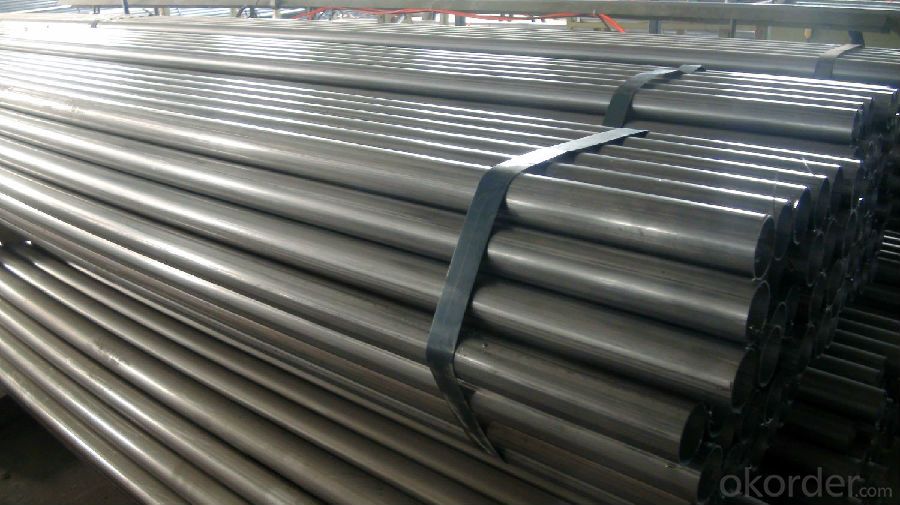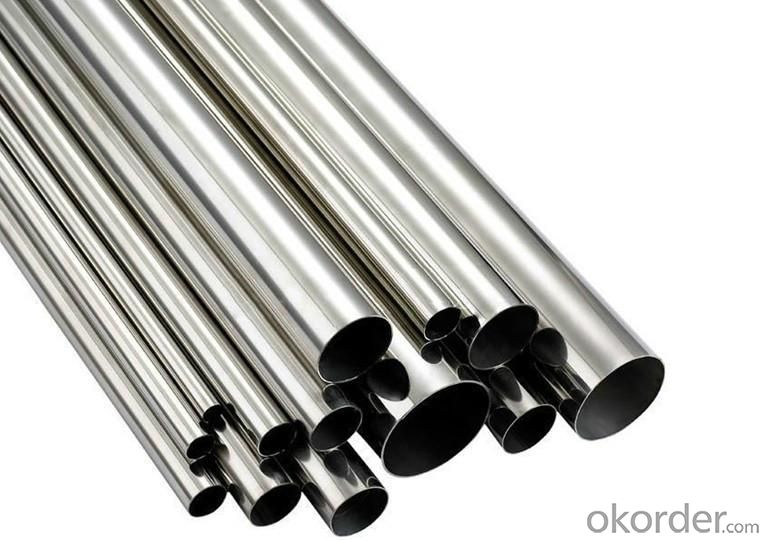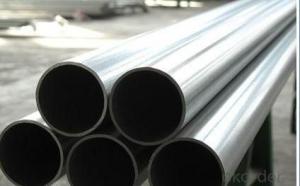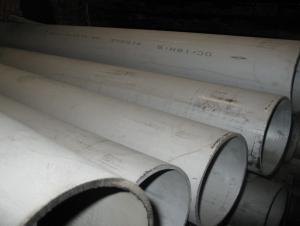304 Stainless Steel Pipe Clamp With Low Price
- Loading Port:
- Tianjin
- Payment Terms:
- TT OR LC
- Min Order Qty:
- 35 m.t.
- Supply Capability:
- 3000 m.t./month
OKorder Service Pledge
OKorder Financial Service
You Might Also Like
Item specifice
304 Stainless Steel Pipe Clamp with low price
1.Structure of Stainless Steel Pipe :
Stainless steel pipe is formed by drawing a solid billet over a piercing rod to create the hollow shell. As the manufacturing process does not include any welding, seamless pipes are perceived to be stronger and more reliable. Historically seamless pipe was regarded as withstanding pressure better than other types, and was often more easily available than welded pipe.
2.Main Features of the Stainless Steel Pipe :
• High manufacturing accuracy
• High strength
• Small inertia resistance
• Strong heat dissipation ability
• Good visual effect
• Reasonable price
3.Stainless Steel Pipe Specification:
Standard | GB, DIN, ASTM ASTM A106-2006, ASTM A53-2007 |
Grade | 10#-45#, 16Mn 10#, 20#, 45#, 16Mn |
Thickness | 8 - 33 mm |
Section Shape | Round |
Outer Diameter | 133 - 219 mm |
Place of Origin | Shandong, China (Mainland) |
Secondary Or Not | Non-secondary |
Application | Hydraulic Pipe |
Technique | Cold Drawn |
Certification | API |
Surface Treatment | factory state or painted black |
Special Pipe | API Pipe |
Alloy Or Not | Non-alloy |
Length | 5-12M |
Outer Diameter | 21.3-610mm |
Grade | 20#, 45#, Q345, API J55, API K55, API L80, API N80, API P110, A53B |
Standard | ASME, ASTM |
4. Application of Stainless Steel Pipe
Stainless steel pipe is used for structural and piping applications that require the properties that stainless steel delivers – high strength, toughness and excellent corrosion resistance. The pipe is available in sizes 1/2" through 36” in outside diameter (OD) and schedules 05S through 80S and larger for wall thickness (WT). It is available as welded and seamless. Stainless pipe has a dull gray, mill finish.
5.Packaging & Delivery
Packaging Details: | seaworthy package,bundles wrapped with strong steel strip |
Delivery Detail: | 50-60days after received 30%TT or Original LC |
6.FAQ of Stainless Steel Pipe :
A. How is the quality of your products?
Our products are manufactured strictly according to national and internaional standard, and we take a test on every pipe before delivered out. If you want see our quality certifications and all kinds of testing report, please just ask us for it.
Guaranteed: If products’ quality don’t accord to discription as we give or the promise before you place order, we promise 100% refund.
B.How about price?
Yes, we are factory and be able to give you lowest price below market one, and we have a policy that “ for saving time and absolutely honest business attitude, we quote as lowest as possible for any customer, and discount can be given according to quantity”,if you like bargain and factory price is not low enough as you think, just don’t waste your time.Please trust the quotation we would give you, it is professional one.
C.
Why should you chose us?
Chose happens because of quality, then price, We can give you both.Additionally, we can also offer professional products inquiry, products knowledge train(for agents), smooth goods delivery, exellent customer solution proposals.Our service formula: good quality+good price+good service=customer’s trust
SGS test is available, customer inspection before shipping is welcome, third party inspection is no problem.
Any question, pls feel free to contact us !
7. Stainless Steel Pipe Images:


8. Company Information:
CNBM International Corporation (CNBM International) is the most important trading platform of CNBM Group Corporation, a state-owned company under the direct supervision of State-owned Assets Supervision and Administration Commission of the State Council.
Since 2004, the trading volume of CNBM International has been doubled in 5 successive years owing to the support of superior corporations and effort of all staff. Meanwhile, we have established strategic partnerships with hundreds of domestic manufacturers and sound business relations with clients from over 120 countries. Currently, we have wholly-owned overseas subsidiaries and branches in 5 countries with a view to realize localization, which also represents an essential progress in our globalization target.
In line with the business, CNBM International launched E-business platform Okorder.com.Our goal is to transform CNBM International into the global leading brand in building materials industry within 3 to 5 years through innovation and reform, by strengthening the overall management of supply chain, developing and cultivating both domestic and overseas market, improving the procedure and information system, enhancing the ability to organize resources and to provide value-added services under a professional team and a learning organization.
- Q:How do you prevent galvanic corrosion in stainless steel pipes?
- To prevent galvanic corrosion in stainless steel pipes, it is crucial to avoid direct contact with dissimilar metals. This can be achieved by using appropriate insulation or protective coatings on the pipes, ensuring that they do not come into contact with materials such as copper or aluminum. Additionally, employing dielectric unions or isolating gaskets at the connection points can help to minimize the risk of galvanic corrosion. Regular maintenance, including inspection and cleaning, is also essential to identify and address any potential issues before they escalate.
- Q:Can stainless steel pipes be used for natural gas systems?
- Indeed, natural gas systems can utilize stainless steel pipes. Given its exceptional resistance to corrosion and ability to withstand elevated pressure and temperature levels, stainless steel emerges as a fitting material for the transportation of natural gas. Additionally, the flawlessly smooth inner surface of stainless steel pipes facilitates efficient gas flow, thereby reducing the likelihood of blockages or obstructions. Nevertheless, it remains crucial to guarantee that the stainless steel pipes employed adhere to the precise standards and codes mandated for natural gas systems, in order to ensure both safety and compliance.
- Q:Can stainless steel pipes be used for sewage and wastewater systems?
- Yes, stainless steel pipes can be used for sewage and wastewater systems. Stainless steel is known for its excellent corrosion resistance, making it highly suitable for applications involving water and sewage. It is resistant to rust, corrosion, and chemical reactions, which ensures a longer lifespan and reduces the need for frequent replacements. Stainless steel pipes also have a smooth surface that prevents the accumulation of debris and facilitates easy cleaning. Additionally, stainless steel is non-porous, preventing the growth of bacteria and fungi, making it hygienic and suitable for sewage and wastewater systems. Its durability, reliability, and resistance to harsh environmental conditions make stainless steel pipes a popular choice for these applications.
- Q:How do you calculate the expansion and contraction of stainless steel pipes?
- In order to determine the expansion and contraction of stainless steel pipes, one must consider the coefficient of thermal expansion specific to the grade of stainless steel being utilized. This coefficient measures the extent to which a material expands or contracts in response to temperature fluctuations. To begin, ascertain the initial length of the stainless steel pipe, typically measured at room temperature. Subsequently, determine the temperature variation to which the pipe will be exposed. This variation is determined by calculating the difference between the maximum and minimum temperatures the pipe will encounter. Following this, multiply the initial length of the pipe by the coefficient of thermal expansion corresponding to the specific grade of stainless steel employed. Since the coefficient of thermal expansion can differ depending on the alloy and composition of the stainless steel, it is important to consult the manufacturer's specifications or engineering references for the specific grade in use. Lastly, multiply the obtained result by the temperature variation to ascertain the expansion or contraction of the stainless steel pipe. A positive value indicates expansion, while a negative value indicates contraction. It is crucial to note that the calculated expansion or contraction of the stainless steel pipe is an approximate value and can vary due to factors such as the specific alloy composition, manufacturing processes, and installation conditions. As such, it is advisable to consult a qualified engineer or refer to industry standards for more accurate calculations in specific applications.
- Q:Are stainless steel pipes suitable for food storage facilities?
- Yes, stainless steel pipes are highly suitable for food storage facilities. Stainless steel is a non-reactive and corrosion-resistant material, making it ideal for handling food and beverages. It does not impart any taste, odor, or contaminants to the stored food, ensuring its quality and safety. Stainless steel pipes are also easy to clean, maintain hygiene standards, and have a long lifespan, making them a preferred choice for food storage facilities.
- Q:How do you prevent oxidation in stainless steel pipes?
- One way to prevent oxidation in stainless steel pipes is by applying a protective coating or paint that acts as a barrier against oxygen and moisture. Additionally, regular cleaning and maintenance can help remove any corrosive substances or deposits that could lead to oxidation.
- Q:What are the factors to consider when selecting stainless steel pipes?
- There are several factors to consider when choosing stainless steel pipes: 1. Take into account the grade of stainless steel. Different grades offer varying levels of corrosion resistance, strength, and durability. It is crucial to select the appropriate grade based on the specific application and environmental conditions. 2. Ensure that the size and dimensions of the stainless steel pipes are suitable for the intended use. Consider factors such as inner diameter, outer diameter, wall thickness, and length to guarantee a proper fit and compatibility with the existing system. 3. Evaluate the corrosion resistance of the stainless steel pipes. While stainless steel is known for its excellent corrosion resistance properties, different grades provide varying levels of protection. Take into account the exposure to corrosive substances and choose a grade that can withstand the specific environment. 4. Consider the pressure and temperature requirements. Stainless steel pipes are commonly used in high-pressure and high-temperature applications. It is crucial to select a grade that can handle the required pressure and temperature without compromising the pipe's structural integrity. 5. Assess the fabrication and installation requirements. When choosing stainless steel pipes, take into consideration the ease of fabrication and installation. Some grades may require special welding techniques or pre-fabrication processes, so it is important to evaluate the feasibility and cost-effectiveness of such requirements. 6. Keep the cost in mind. The cost of stainless steel pipes can vary depending on the grade, size, and other factors. It is important to consider the budget and find a balance between cost and desired quality and performance. 7. Ensure compliance with regulatory and industry standards. Depending on the application, there may be specific standards and regulations that need to be met. Make sure that the selected stainless steel pipes comply with these standards to ensure safety and reliability. By considering these factors, one can make an informed decision when selecting stainless steel pipes that meet the specific requirements of their application.
- Q:Can stainless steel pipes be used for chemical storage tanks?
- Yes, stainless steel pipes can be used for chemical storage tanks. Stainless steel is highly resistant to corrosion and can withstand the harsh chemicals found in many industrial processes. Additionally, stainless steel pipes are durable, easy to clean, and have a long lifespan, making them a suitable choice for chemical storage applications.
- Q:What are the common types of fittings used with stainless steel pipes?
- There are several common types of fittings used with stainless steel pipes. Some of the most commonly used fittings include: 1. Stainless Steel Threaded Fittings: These fittings have threaded ends that allow them to be easily connected to pipes or other fittings. They are typically used in low-pressure applications and can be easily installed or removed using a wrench. 2. Stainless Steel Butt-Weld Fittings: Butt-weld fittings are used to connect stainless steel pipes with a seamless method. These fittings are welded directly to the pipe, providing a strong and leak-free connection. Butt-weld fittings are commonly used in high-pressure or high-temperature applications. 3. Stainless Steel Flanges: Flanges are used to connect pipes or fittings together by bolting them together. They provide a secure and rigid connection that can be easily disassembled when needed. Flanges are available in various types such as slip-on, weld neck, socket weld, and blind flanges. 4. Stainless Steel Compression Fittings: Compression fittings are used to create a tight seal between pipes by compressing a ferrule against the pipe. They are commonly used in plumbing systems and provide a reliable and leak-free connection. 5. Stainless Steel Camlock Fittings: Camlock fittings are quick-connect fittings that are commonly used in industrial applications. They have a male and female end that can be easily connected by simply pushing them together and then locking them in place. Camlock fittings are known for their ease of use and versatility. Overall, these are some of the common types of fittings used with stainless steel pipes. The choice of fitting depends on the specific application, pressure, temperature, and other factors. It is important to select the right fitting to ensure a secure and reliable connection.
- Q:Can stainless steel pipes be used for power generation?
- Yes, stainless steel pipes can be used for power generation. Stainless steel is a highly versatile and durable material that is commonly used in various industries, including power generation. It offers excellent corrosion resistance, high strength, and heat resistance, making it suitable for applications involving high temperatures and pressures. In power generation, stainless steel pipes are often used in the construction of power plants, including fossil fuel-fired plants, nuclear power plants, and renewable energy facilities. They are used for transporting various fluids, such as steam, water, and fuel, within the power generation system. Stainless steel pipes are particularly beneficial in power generation due to their ability to withstand extreme conditions, including high temperatures and corrosive environments. They provide excellent resistance against corrosion, which helps to maintain the integrity and longevity of the pipes, ensuring the continuous and reliable operation of power generation systems. Furthermore, stainless steel pipes are highly resistant to thermal expansion and contraction, which is crucial in power generation applications that involve frequent temperature changes. This characteristic helps to prevent leaks and maintain the overall efficiency of the power generation process. In conclusion, stainless steel pipes are widely used in power generation due to their excellent corrosion resistance, high strength, and ability to withstand extreme conditions. They play a vital role in transporting fluids within power plants and contribute to the overall efficiency and reliability of power generation systems.
1. Manufacturer Overview |
|
|---|---|
| Location | |
| Year Established | |
| Annual Output Value | |
| Main Markets | |
| Company Certifications | |
2. Manufacturer Certificates |
|
|---|---|
| a) Certification Name | |
| Range | |
| Reference | |
| Validity Period | |
3. Manufacturer Capability |
|
|---|---|
| a)Trade Capacity | |
| Nearest Port | |
| Export Percentage | |
| No.of Employees in Trade Department | |
| Language Spoken: | |
| b)Factory Information | |
| Factory Size: | |
| No. of Production Lines | |
| Contract Manufacturing | |
| Product Price Range | |
Send your message to us
304 Stainless Steel Pipe Clamp With Low Price
- Loading Port:
- Tianjin
- Payment Terms:
- TT OR LC
- Min Order Qty:
- 35 m.t.
- Supply Capability:
- 3000 m.t./month
OKorder Service Pledge
OKorder Financial Service
Similar products
New products
Hot products
Hot Searches
Related keywords

























